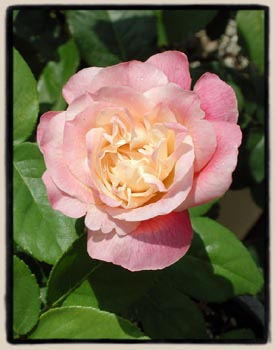 |
|
Albas |
Welcome to the December 2003 edition of my web site! The roses I write about are the Old Garden Roses and select shrub and miniature roses of the 20th century. For tips on rose culture, pruning, propagation and history, see the "Site Resources Guide" box in the navigation panel at left. To return to this page, click on the "thorn icon" in the margin at left. Articles from the previous months are archived and can be viewed by clicking on the listings in the left margin. Oh, and please don't write to me for a catalog or pricelist.....this is an information site only, not a commercial nursery. If you wish to buy roses, see my sponsor, The Uncommon Rose.
What is a Tea Rose? During the spring of 1999 I got frustrated with the difficulty of identifying the Tea roses I had found in Santa Cruz, and decided that since I can't find a good book on identifying Tea roses, I might as well write one. To do research for the book, I went to the San Jose Heritage Rose Garden. I took a camera and a notebook and my preliminary list of Tea roses, and set about taking photos and notes, and measuring sizes of leaves and flowers. Then I saw `Gloire de Dijon.' In The Old Rose Advisor, it's a Noisette. In San Jose it's a Tea. In Les Roses Anciennes, it's a Bourbon. That was the first of many roses I found placed in the Tea class by some, placed in the Noisette or Bourbon or China or Hybrid Tea class by others. Even some famous Teas like `Lady Hillingdon' were not considered "true Teas" by all rosarians. How would I decide what to include in my book? Where should I draw the line between Teas and not-quite-Teas? My subsequent research on the early history of Tea rose breeding has shed some light on the subject, and I would like to share it with you. As roses were imported from China to Europe, they were bred with each other, resulting in many of the early tea and china roses. Those with fragrance were called "tea-scented chinas," the others just "chinas." The class distinction had not yet emerged, and didn't until about a decade after `Park's Yellow Tea-Scented China' arrived in France in 1824.
Before
proceeding, it should be mentioned that even where parentage of a rose
is given, there is still an element of doubt, especially with respect
to the pollen parent. Much of what we read about parentage is tradition,
written down many years after the rose was bred, rather than notes left
by the breeder. There are also many Tea roses that have been found,
identified based on descriptions,
Parson's Pink China is perhaps the most important rose in the ancestry
of the Tea roses. On the Ile de Bourbon, hedges were grown alternating
`Parson's Pink China' and an Autumn Damask- `Tous Les Mois'. A hybrid
seedling was found growing in a hedge and named `Rose Edouard' which
became the progenitor of the Bourbon class of roses. The Bourbon rose,
`Mme Desprez' was a cross of Rose Edouard probably with a Noisette rose.
In South Carolina, `Parson's Pink China' crossed with R. moschata, producing
`Champney's Pink Cluster' (1811). It's seedling, `Blush Noisette' (1814)
gave rise to the Noisette
`Adam,' `Devoniensis' and `Safrano' were among the first roses in the Tea Rose class. `Adam' (1838) is said to be a hybrid of `Hume's Blush' and `Rose Edouard.' `Devoniensis' (1838) was `Smith's Yellow China' backcrossed to its parent `Park's Yellow.' `Safrano' (1839) was `Park's Yellow' crossed with `Mme Desprez.' Thus we see that the Tea class started with a significant infusion of China, Noisette and Bourbon. `Gloire de Dijon' is truly in a class by itself. It is said to have been a seedling of an unnamed Tea rose (or perhaps a Tea-Noisette) pollinated by the Bourbon rose `Souvenir de la Malmaison,' which itself was a seedling of `Mme Desprez pollinated by a Tea rose, possibly `Devoniensis.' This explains my confusion expressed in the first paragraph. But wait! There's more! Its parentage indicates that genetically Gloire de Dijon should be diploid (14 chromosomes), but tests have shown it to be tetraploid (28 chromosomes). This, I believe, required a genetic mutation at the earliest stage of seed production.
In
trying to determine what is or is not a Tea rose, several things need
to be considered. In roses where the parents are given, the presence
of Noisette, China or Bourbon is, by itself, not sufficient reason to
exclude a rose from the Tea class, since all those groups helped make
the Tea class. Thus, `Lady Hillingdon' is still a Tea rose. With found
roses that appear to be teas, consider the following. Tea leaves are
large relative to the flower. They have ovate-lanceolate leaflets, the
terminal one of which is noticeably larger than the others; the lowest
pair is smaller and pointed toward the stem. The thin petiole is often
curved, and has hooked prickles on the back. Characteristics that differ
from these indicate the influence of another class in the rose's ancestry.
However, we don't have clear standards on where to draw the line between
Teas and other classes, and the problem becomes worse when we don't
know the ancestry of the rose. Unless we can come up with a checklist
of characteristics to identify a Tea Rose, we will continue to have
the possibility of the same rose being placed in different classes. At
right: 'Mme. Lombard'.
There
have been |
|


 At
right: 'Rosette Delizy'.
At
right: 'Rosette Delizy'. At
left: 'Mons. Tillier'.
At
left: 'Mons. Tillier'. At
right: 'Unidentified collected Tea'.
At
right: 'Unidentified collected Tea'. 
